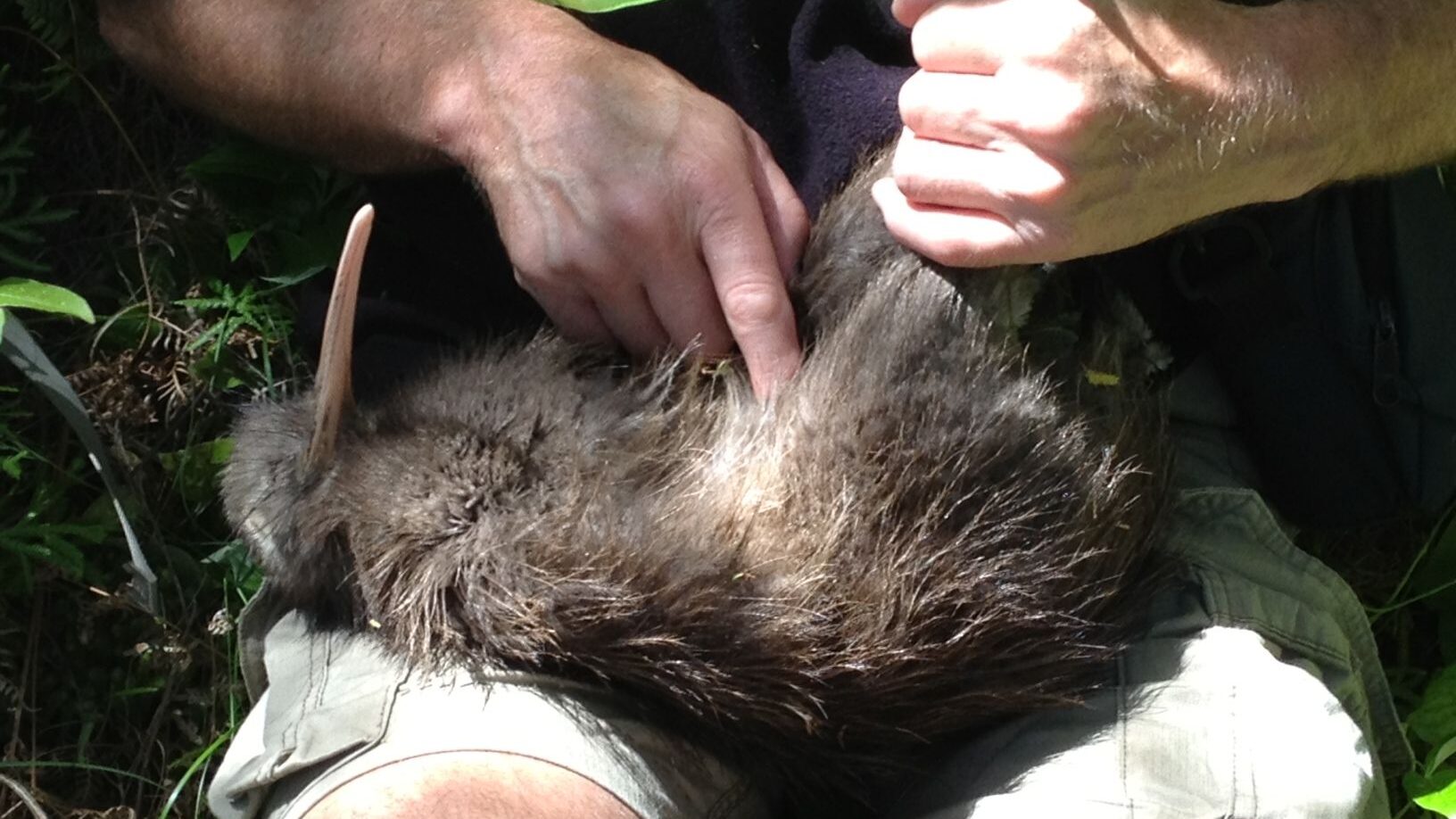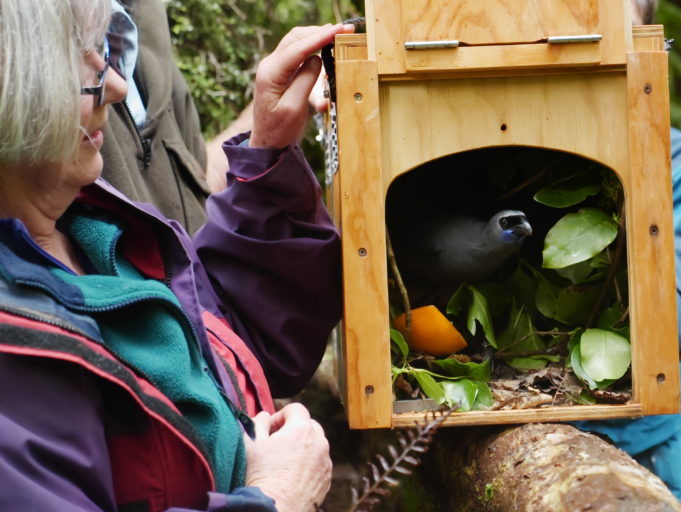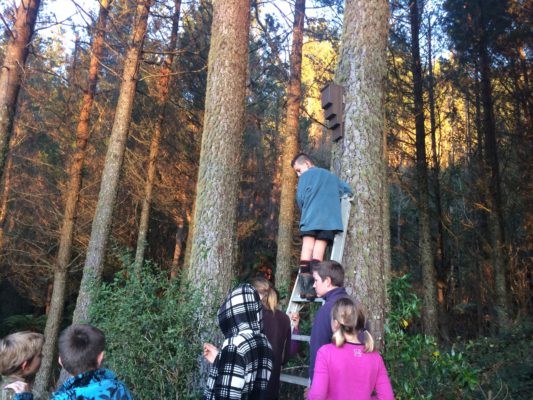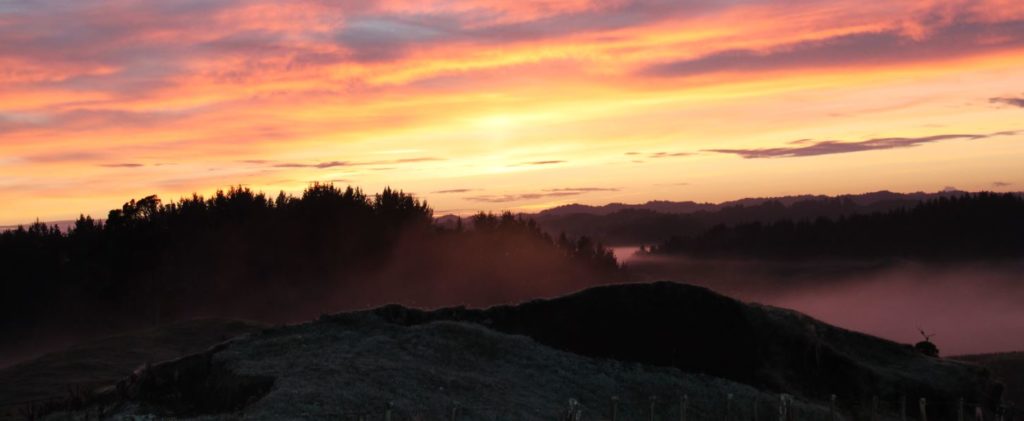Bob and Karen Schumacher have been working “8 days a week since 2004” to help kiwi at their QEII covenanted property at Purangi in East Taranaki, with an extensive trapping programme using best practice techniques that has steadily grown to encompasses more and more wildlife habitat.

“We do the basics consistently, month in, month out,” says Karen, who manages Purangi Kiwi, the main conservation project of the East Taranaki Environment Trust. “We started out trapping over 192 hectares in 2004. That increased to 3000 hectares in 2005 and by 2009 it was 13,000 hectares.”
The East Taranaki Environment Trust is a charitable trust set up by Karen and Bob to help the resident population of North Island western brown kiwi but all wildlife at Purangi Kiwi is benefiting.

“Kiwi are our indicator species,” explains Karen. “Our belief was that if kiwi are doing well, so will all the other species in the programme area and that has proved to be correct. North Island robins are everywhere. There are fernbirds, tui, whitehead, rifleman. Falcon are breeding and the number of long-tailed bats is really growing. Habitat is improving out of sight!”
Kiwi numbers are increasing at a rate of around 9% per year.
“When we started there were a lot of older birds in the core population. We started the protection just in time. Now there are estimated to be over 4000 kiwi.”
Such is the success of the Purangi Kiwi project that kokako have recently been released at Purangi and perhaps the Environment Trust will need to look at renaming their project as ‘Purangi Kiwi and Kokako’ in the near future.
“The first kokako arrived in June this year,” says Karen. “It’s been an 8-year journey for us. There will be 3 blocks of releases with 20 kokako released this year and another 20 to be released over the next couple of seasons.”
The founder population of 40 birds is from Hauturu/Little Barrier Island and it is the first time kokako have been taken off the island. They are considered to have a slightly different genetic makeup to the kokako population on the mainland, so having a second, mainland population of Hauturu kokako is good both for mainland genetic diversity and as a backup to the Hauturu population.
Intensive ground pest control is needed for kokako to establish successfully.
“We have a network of about 1300 DOC 200 traps,” Karen explains, “along with a growing network of 712 re-setting A24 traps and 340 resetting A12 traps for possums. There is a core control block of 1042 hectares and we also control feral goats throughout the project area. It’s also important to do regular field audits of traps to make sure they’re working properly.”
Along with a growing volunteer base, Purangi Kiwi employs a core group of contractors to manage the traplines and employs 2 fulltime and 2 part-time staff.

“Our greatest challenge is funding and achieving financial sustainability,” says Karen. “We are a community group but have a DOC-sized project, so we don’t fit normal funding criteria. It’s a huge issue we’re facing at the moment – getting sustainable funding for our operational work.”
Karen estimates that the total cost of running the project – including volunteer hours – is around $46 per hectare.
“When there’s a shortfall, Bob and I make it happen,” she says.
There have been many moving and rewarding moments along the way.
“At the very beginning of the project we were in the bush and saw some adult kiwi footprints with baby prints alongside,” Karen recalls. “We both said ‘yes!’ and punched the air! Then last year we had to catch a kiwi to check its transmitter and flooding delayed us, so that it was right on the cusp of when his egg was hatching. We rang Rotorua Kiwi Encounter to say we were on our way with the newly hatched chick and they told us that the greatest risk to the chick was hyperthermia.”
Kiwi chicks look cute and fluffy once they’ve recovered from hatching – but this one was still wet and sticky.
“As instructed by Kiwi Encounter I was ready to put it on my tummy to keep it warm for the whole trip,” says Karen. “The things you’re prepared to do… It was awesome. It was so vulnerable.”
And then there was a kiwi named Maru.
“Maru had worn a transmitter since we started. He was a non-breeder – over 50 years old and he died of natural causes in January this year,” says Karen.
Maru’s transmitter was donated to the Puke Ariki/Taranaki Museum in New Plymouth where staff are in the process of setting up a permanent Purangi Kiwi exhibition in the ‘Natural Taranaki’ section.
“Bob took Maru’s transmitter off and just left him where he lay in his own territory,” Karen says. “It was really sad – like losing a family member.”
The new exhibition at Puke Ariki has been an exciting development for Karen and Bob.
“It’s been about 2 years work and has had some challenges with things like special effects for the long-tailed bats,” says Karen. “It’s looking awesome and we’re really excited about it. It will be opening very soon.”
The exhibition should help spread the word about Taranaki’s wildlife and the conservation work being carried out by dedicated conservationists like Karen, Bob and fellow members of the East Taranaki Environment Trust.
The Trust has also developed it’s own educational programme at Purangi with units on kiwi, long-tailed bats and bugs/micro-invertebrates. The programme is mostly aimed at primary school pupils at the moment, but preschool groups also visit Purangi and pupils from several different local high schools come out to Purangi for community service work.
Each year two public walks are held over summer for the local community to come out and learn about the work of the trust. The walks also serve as a fund-raiser for the Trust.
The presence of bats has been something of a pleasant surprise for Purangi Kiwi and primary school pupils have been a key part of a study to learn more about them.
“We knew we had bats when we were doing some night kiwi work and someone got hit by bats,” says Karen. “We’re thrilled to have them. A couple of years ago we did a study with acoustic recorders for 20 days where listeners picked up the bat sonar. Children and parents took part as part of the primary school programme and the children analysed the data. It was a really cool learning experience.”

The sonar monitoring was repeated last summer and there was a substantial increase at all the different sites.
Bats, kiwi and now kokako are thriving at Purangi, along with many other species and the results are a testament to the hard work and dedication of the Schumachers, their fellow Trust members, volunteer supporters and staff. Kiwi numbers did, however, decrease by 1 just recently in an event that astounded the Karen and Bob. Bertrand the Kiwi went missing!
“Bertrand is a female kiwi, named after an early settler family,” says Karen. “Kiwi are hard-wired to go AWOL. It increases genetic diversity if they travel to find a mate.”
Bertrand, however, went a little more AWOL than most and even managed to cross the Waitara River. Kiwi can’t fly but it seems they can swim when they want to.
“We plan to put a plane up to try and find her!” says Karen.
There is no bridge over the Waitara she could have used, no logs to make the journey easier. Purangi Kiwi has the Waitara River running through the project area, but no other kiwi had ever crossed.
Young Bertrand, less than a year old, is clearly a kiwi of exceptional determination. Her story even made the national headlines back in July this year. Bertrand’s off on her travels again now – a travelling ambassador for the success of the Purangi Kiwi breeding programme.

